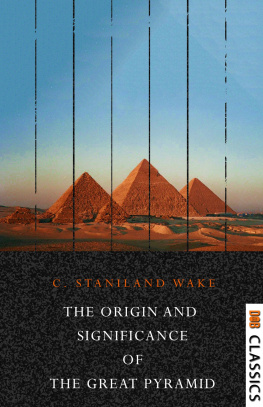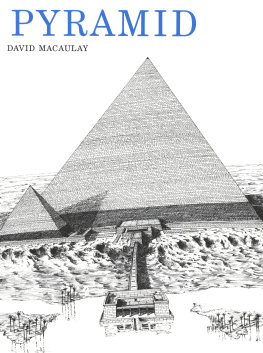Origin and Significance of The Great Pyramid
By
C. Staniland Wake
First digital edition 2019 by Gianluca Ruffini
PREFACE
The subject treated of in the following pages has during the last few years attracted much attention, thanks to the influence of Prof. C. Piazzi Smyth's important work, Life and Work at the Great Pyramid.
It was to test, by the light of history, the conclusion accepted by that writer as to the inspired origin of the Great Pyramid that I entered upon a consideration of the subject. That such an origin was required by the facts, I did not suppose, but the conviction was forced on me that the structure had much more importance, viewed as a scientific and religious monument, than was generally conceded. I found nothing, however, to show that either its design or its construction necessitated Divine intervention. I was led to the conclusion, nevertheless, that the builders of the Great Pyramid intended to perpetuate certain scientific ideas, and, moreover, that they had a religious motive in its erection.
There is little doubt, indeed, that it is a monument of Sabaism, the worship of the heavenly host, which had a wide extension in the ancient world, and with which Serpent worship was intimately connected. The importance of the Great Pyramid as a religico-scientific structure is still further increased if, as is not improbable, it was intended to mark the substitution of an astronomy based on the passage of the sun through the twelve signs of the Zodiac for the lunar astronomy which preceded it.
My endeavour has been to state fairly the historical conditions of the problem considered, and to point out the direction in which its solution must be sought. With the question as to the original source from which the wisdom of the Ancients, of which the Great Pyramid is so wonderful a monument, was derived, these pages are not concerned.
The Serpent, enclosed in a pyramid, given on the cover, is taken from a gem figured in Matter's Histoire Critique du Gnosticism, planche II B, figure 2. It is there said to be the Solar Chnouphis or Agathodemon, Christos, with the seven sons of Sophia (Wisdom), the seven planetary genii.
The substance of this little work was read as a Paper before the Hull Literary Club on the 13th March, 1882.
CHAPTER I: THE ASTRONOMICAL THEORY
THE GREEKS of the time of Alexander the Great were so impressed with the magnitude or splendour of certain edifices, that they spoke of them as the seven wonders of the world. Among these, the first place was given to the Pyramids of Egypt, and pre-eminently to those of Ghizeh, which are situate a few miles from Cairo, and in the neighbourhood of ancient Memphis. The Pyramids of Ghizeh form a group of nine, consisting of three large ones, known as the Pyramid of Cheops, or the Great Pyramid; that of Cephren; and that of Mycerinus, which is inferior in size to either of the others. The six other pyramids of the Ghizeh group are much smaller, and arc supposed to be the tombs of female relatives of the kings who constructed the larger ones. From the term Great applied to the largest pyramid, it might be thought that it far exceeds in size any of the others. As a fact, however, the Pyramid of Cephren is not very much smaller than that of Cheops, which was about 756 feet square at the base and 480 feet high, as against 707 feet 9 inches the extreme length of the sides, and 454 the height, of the Second Pyramid.
Moreover, the construction of the two pyramids was, according to Col. Vyse, carried on upon the same principles. This is true more especially of the general design and external characters of the buildings, which in their internal features, however, differ considerably. The position of the chambers, and the inclination of the passages of the Great Pyramid are exceptional, and, judging from these peculiarities and from certain scientific facts supposed to be embodied in it, several modern writers have affirmed that the design for the Great Pyramid must have been derived from an inspired source. The originator of this theory was John Taylor who in 1859, published a book on the subject (1) and as in recent years it has attracted considerable attention, chiefly through its adoption by the author of Life and Work at the Great Pyramid, Prof. C. Piazzi Smyth, the Astronomer Royal of Scotland, and as the scientific facts on which it is based are admittedly true, it is necessary to consider the theory.
In the first place, the Great Pyramid is said to embody in its form and proportions certain facts as to the size and shape of the earth. Thus, John Taylor says that the builders of the Great Pyramid imagined the earth to be a sphere, and as they knew that the radius of a circle must bear a certain proportion to its circumference, they built a four-sided pyramid of such a height in proportion to its base that its perpendicular would be the radius of a sphere equal to the perimeter of the base. This shape is supposed to have reference to an important astronomical fact, seeing that the vertical height of the Great Pyramid multiplied by 10 to the 9th power (109) tells the mean distance of the sun from the earth, that is, one thousand million times the pyramids height, or 91,840,000 miles. (2)
Moreover, the Great Pyramid is thought to supply a standard of linear measure, based on the length of the polar axis of the earth. Assuming this length to be 500,500,000 of our inches, the 500 millionth of that axis (omitting fractions) will be one inch. Of these inches, 25 or 25.025 of our inches would form a cubit or longer standard, the ten millionth part of the semi-axis of the globe in length, which is the measure of the sacred cubit of the ancient Hebrews. This cubit of 25 earth inches is contained in each side of the Great Pyramid as many times as there are days in the year, and the inch itself is contained separately and independently in the entire perimeter of the Great Pyramids base just one hundred times for each day of the year.
The inch is also said to be the representative of a year in the reckoning of the passage floor lines as charts of history, also in the diagonals of the pyramids base taken as a measure of the precessional cycle. The Great Pyramid is found, moreover, to furnish an important weight and capacity measure having relation to the mean density or specific gravity of the earth. These earth measures are said to be reproduced in the Coffer preserved in the large or so-called Kings Chamber of the Great Pyramid, the internal capacity of which vessel is just four times the measure of an English quarter of wheat.
The Great Pyramid was thus, according to the holders of the inspiration theory, originally designed as a perfect and complete metrological monument. This conclusion is thought to be supported by the great astronomical knowledge possessed by the builders, who were aware, not only of the shape and rotatory motion of the earth, but also of its distance from the sun. They were able, further, to do what was found so difficult up to a comparatively recent date--to fix with precision the position of the four cardinal points, as is shewn by the fact that the pyramid stands due North, South, East, and West.
The Great Pyramid is thus seen to be an important astronomical monument, and it is no less remarkable in relation to certain chronological facts. It is supposed to perpetuate the great cycle founded on the precession of the equinoxes. This siderial year is equal to 25,868 of our years, and the two diagonals of the pyramids base taken together are said to measure just the same number of inches. It is thought, moreover, that by means of this cycle the date of the erection of the pyramid can be ascertained. Assuming that the long narrow downward passage leading from the entrance was directed towards the pole star of the pyramid builders, astronomers have shown that in the year 2,170 B.C. the passage pointed to Alpha Draconis, the then pole star, at its lower culmination, at the same time that the Pleiades, particularly Alcyone, the centre of the group, were on the same meridian above. This relative position of Alpha Draconis and Alcyone being an extraordinary one, as it could not occur again for a whole siderial year, it is thought to mark the date of the building of the Great Pyramid.







